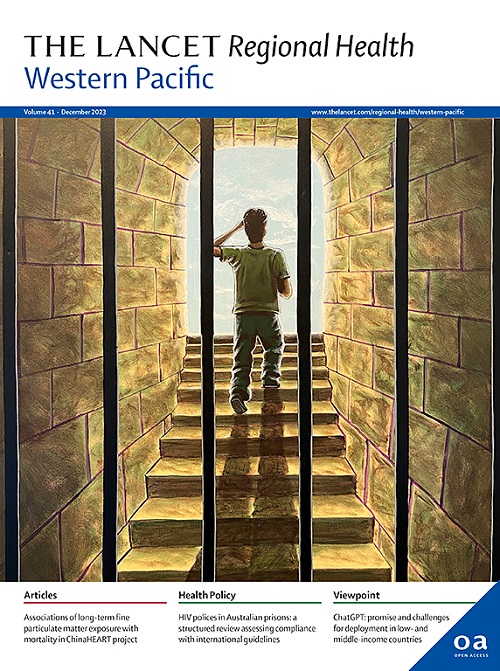Redefining the association of triglycerides with all-cause and Cardiovascular Disease Mortality in the Chinese population: a nationwide, population-based, prospective cohort study of 3.8 million Chinese adults
IF 8.1
1区 医学
Q1 HEALTH CARE SCIENCES & SERVICES
引用次数: 0
Abstract
Background
Current international guidelines on dyslipidemia were formulated based on the research performed mostly in White populations. However, whether the association of triglycerides (TGs) with cardiovascular disease (CVD) differs between Chinese and White populations is unknown.
Methods
3,789,025 participants from the China Health Evaluation And risk Reduction through nationwide Teamwork (ChinaHEART) were evaluated for the association between TGs and all-cause and CVD mortality with Cox regression models. The findings were tested for sex-specific differences and contrasted with another comparison cohort of 434,919 UK Biobank participants.
Findings
92,888 Chinese adults died during a median follow-up of 4.6 years. All-cause and CVD mortality initially increased with TG elevation abruptly and plateaued in Chinese men, while U-shaped associations were seen in Chinese women. In contrast, CVD risk increased incrementally with TGs in White people. Hazard ratios (95% confidence intervals) were 1.02 (0.97–1.07), 1.05 (1.00–1.11), 1.07 (1.02–1.22), and 1.19 (1.13–1.24) from TG quintile 2 to 5 for White men, and 1.14 (1.08–1.21), 1.17 (1.11–1.24), 1.26 (1.18–1.33), and 1.41 (1.33–1.50) for White women, respectively. The association with CVD mortality was stronger in Chinese men who were lean, normotensive, and smoking but in Chinese women with diabetes.
Interpretation
The association of TGs with CVD was different for the White and the Chinese populations. That mortality risk elevated in conventionally low-to-moderate TG range implicates that more aggressive intervention may be merited for Chinese and other East Asian populations.
Funding
The National High Level Hospital Clinical Research Funding (2023-GSP-ZD-2, 2023-GSP-RC-01), the Ministry of Finance, and the National Health Commission of China.
重新定义甘油三酯与中国人群全因和心血管疾病死亡率的关系:一项380万中国成年人的全国性、基于人群的前瞻性队列研究
目前国际上关于血脂异常的指南是基于主要在白人人群中进行的研究而制定的。然而,甘油三酯(tg)与心血管疾病(CVD)的相关性在中国人和白人人群中是否存在差异尚不清楚。方法采用Cox回归模型对中国健康评估与全国团队合作降低风险项目(ChinaHEART)的37789025名参与者进行TGs与全因死亡率和CVD死亡率的相关性评估。研究人员对研究结果进行了性别差异测试,并与另一组434,919名英国生物银行参与者进行了对比。研究发现,在平均4.6年的随访期间,92888名中国成年人死亡。中国男性的全因死亡率和CVD死亡率最初随着TG升高而突然增加,并趋于稳定,而中国女性的全因死亡率呈u型关系。相比之下,白人患心血管疾病的风险随着tg的增加而增加。白人男性TG五分位数的风险比(95%置信区间)分别为1.02(0.97-1.07)、1.05(1.00-1.11)、1.07(1.02 - 1.22)和1.19(1.13-1.24),白人女性的风险比分别为1.14(1.08-1.21)、1.17(1.11-1.24)、1.26(1.18-1.33)和1.41(1.33-1.50)。与心血管疾病死亡率的相关性在瘦弱、血压正常和吸烟的中国男性中更强,但在患有糖尿病的中国女性中更强。白人和中国人的TGs与CVD的关系不同。在传统的低至中等TG范围内,死亡风险升高意味着中国和其他东亚人群可能需要更积极的干预。国家高水平医院临床研究专项资金(2023-GSP-ZD-2、2023-GSP-RC-01)、财政部、国家卫生健康委员会资助。
本文章由计算机程序翻译,如有差异,请以英文原文为准。
求助全文
约1分钟内获得全文
求助全文
来源期刊

The Lancet Regional Health: Western Pacific
Medicine-Pediatrics, Perinatology and Child Health
CiteScore
8.80
自引率
2.80%
发文量
305
审稿时长
11 weeks
期刊介绍:
The Lancet Regional Health – Western Pacific, a gold open access journal, is an integral part of The Lancet's global initiative advocating for healthcare quality and access worldwide. It aims to advance clinical practice and health policy in the Western Pacific region, contributing to enhanced health outcomes. The journal publishes high-quality original research shedding light on clinical practice and health policy in the region. It also includes reviews, commentaries, and opinion pieces covering diverse regional health topics, such as infectious diseases, non-communicable diseases, child and adolescent health, maternal and reproductive health, aging health, mental health, the health workforce and systems, and health policy.
 求助内容:
求助内容: 应助结果提醒方式:
应助结果提醒方式:


